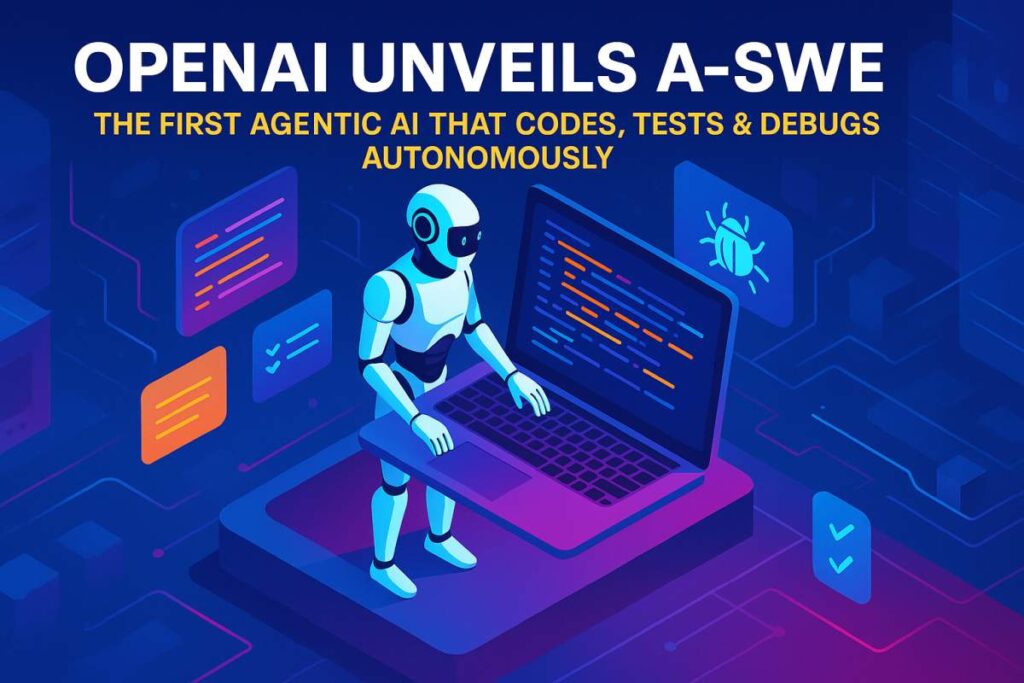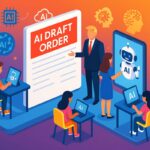OpenAI A‑SWE: Autonomous AI That Codes & Debugs
Introduction: A New Era in AI-Driven Development
Imagine an AI that doesn’t just suggest code snippets but autonomously designs, builds, tests, and ships an entire application—complete with documentation and quality assurance. That’s the promise behind OpenAI A‑SWE (Agentic Software Engineer), unveiled on April 20, 2025. By moving beyond assistive tools like GitHub Copilot, A‑SWE represents a fresh shift toward truly agentic AI. In this article, we’ll explore how A‑SWE works, compare it to existing solutions, examine real-world demos, discuss industry implications, and offer insights on what this means for developers, businesses, and the future of software engineering.

1. From Assistive to Agentic: Defining OpenAI A‑SWE
For years, AI tools like GitHub Copilot have boosted developer productivity by suggesting lines of code or auto‑completing functions. However, these remain fundamentally assistive—they rely on developer prompts and oversight. OpenAI A‑SWE, by contrast, is agentic: it sets its own plan, carries out tasks end-to-end, and self-validates outcomes.
- Autonomy in Action: A‑SWE interprets high-level project goals (“build a to-do app with user authentication”) and decomposes them into a sequence of coded modules, tests, and documentation steps.
- Self‑Managed QA: It runs unit tests, flags failures, and iteratively patches code until all tests pass (Entrepreneur).
- Automated Documentation: A‑SWE generates user guides, README files, and API references, bridging a gap often overlooked by busy development teams.
Table 1: Assistive vs. Agentic AI Comparison
| Capability | Assistive AI (e.g., Copilot) | Agentic AI (OpenAI A‑SWE) |
|---|---|---|
| Task Initiation | Developer prompts required | Interprets objectives autonomously |
| Code Authoring | Snippet suggestions | Full module and component creation |
| Testing & QA | Manual trigger; human review | Automatic testing and self‑fix |
| Documentation | Inline comments only | Complete technical docs generated |
| Integration | IDE plug‑in | SDK/API integration in pipelines |
2. Under the Hood: Key Architecture and Workflows
At its core, OpenAI A‑SWE combines a powerful LLM (large language model) with a task orchestration and execution engine:
- Natural Language Planner
- Parses user requirements expressed in plain English and divides them into discrete tasks.
- Sandboxed Execution Environment
- Spins up containerized environments to write, compile, and run code safely.
- Continuous Feedback Loop
- Monitors test outcomes, debug logs, and performance metrics to decide next actions (LiveMint).
By repeating these cycles, A‑SWE advances through design, implementation, testing, and deployment phases much like human engineers do—but with greater speed and consistency.
3. Real‑World Demos & Developer Feedback
3.1 Prototype Builds in Minutes
Early demonstrations highlight A‑SWE’s ability to craft end-to-end applications:
- Full-Stack Todo App: From user login flows to database schemas, A‑SWE delivered a working React frontend with a Node.js/Express backend and an integrated CI/CD pipeline in under ten minutes.
- Serverless Microservices: In one demo, it generated AWS Lambda functions paired with API Gateway configurations, complete with automated unit tests.
3.2 Beta Tester Insights
Developers who tested the private beta reported:
“A‑SWE handled our regression suite better than junior engineers did in our last sprint—it caught edge cases we usually miss.” – Senior QA Lead, fintech startup.
“The autogenerated documentation was surprisingly thorough—saving us at least half a day of manual writing.” – CTO, healthcare software firm.
Such feedback underscores how agentic AI can elevate both productivity and product quality.
4. Implications for the Software Industry
The emergence of tools like OpenAI A‑SWE carries both promise and caution:
4.1 Productivity Amplification
- Rapid MVP Development: Startups can launch minimum viable products faster, iterating on features rather than boilerplate code.
- DevOps Streamlining: Automated pipelines reduce human error in testing, deployment, and rollbacks.
4.2 Workforce Evolution
- Role Shifts: Developers will likely pivot from writing routine code to higher‑level tasks—architecture, design, and AI oversight.
- Skill Focus: Emphasis on system design, prompt engineering, and governance of AI agents.
4.3 Ethical, Security & Governance Considerations
AI‑generated code raises questions around:
- Code Provenance: Ensuring compliance with open-source licenses and avoiding unintended IP violations.
- Vulnerability Management: Verifying that auto‑generated code meets security standards and is free from common exploits.
- Data Access Guardrails: Restricting AI’s access to sensitive databases or external services to prevent leaks.
Organizations should establish rigorous review processes and clear policies when integrating agentic AI into their workflows.
5. Where OpenAI A‑SWE Fits in Your Tech Stack
5.1 Ideal Use Cases
- MVP & Prototyping: Quickly validate product ideas with working prototypes.
- CI/CD Automation: Offload repetitive pipeline maintenance and testing.
- Documentation & Onboarding: Generate guides for new hires or open-source contributors.
5.2 Integration Strategies
- API‑First Adoption: Use A‑SWE via RESTful or gRPC endpoints, embedding it into existing DevOps pipelines.
- IDE Plugins (Coming Soon): Directly interact with the agent during code reviews and pull requests.
By aligning A‑SWE to specific pain points—like slow QA or sparse documentation—you can maximize its ROI.
6. Looking Ahead: The Roadmap for Agentic AI
OpenAI’s stated plans for A‑SWE include:
- Expanded Language Support: Beyond JavaScript and Python to languages like Java, C#, and Go.
- Collaboration Mode: Multiple A‑SWE agents coordinating on complex, multi-module projects.
- Interactive Debugging UI: Visual dashboards to track task progress, test coverage, and performance metrics.
These enhancements point toward a future where AI engineers become standard fixtures across development teams of all sizes.
Conclusion: Embrace the Agentic Revolution
OpenAI A‑SWE is more than a novelty—it signals a paradigm shift in how software gets built. By autonomously handling code creation, testing, debugging, and documentation, A‑SWE empowers teams to focus on innovation and strategic vision rather than rote tasks.
Call to Action: How would you leverage an AI engineer on your next project? Share your thoughts below, subscribe for more cutting‑edge AI news, and explore our deep‑dive comparison @ TransFormInfoAI.com


